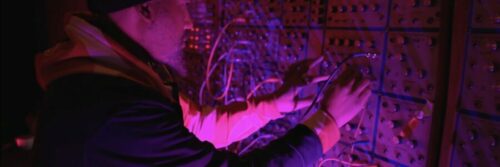Morton Subotnick’s ‘Sidewinder’, Performed Live at Tool’s Studio
Synthesist and synth designer Peter Grenader shared this live studio performance of Morton Subotnick‘s 1971 modular synthesizer work, Sidewinder.
Original Sidewinder was performed by synthesists Jill Fraser, Shiro Fujioka, Peter Grenader and Thomas Klepper. The performance was produced, arranged and mixed by Grenader.
The piece was performed live at Tool’s studio on March 26th, 2023, at the invitation of Subotnick’s spouse, composer and vocalist Joan La Barbara, in celebration of his 90th birthday.
Sidewinder is one of several pioneering albums by Subotnick – along with Silver Apples of the Moon, Touch, Until Spring and others – that have influenced generations of synthesists. These works represented the cutting edge of modern synthesis when they were released and, even 50 years later, they still sound avant garde to many listeners.
The idea of an adaptation of Sidewinder has been on the radar of zZyzx Society’s Fraser and Grenader – both CalArts alumni who worked with Subotnick – for years. The process began with an abridged orchestration, drafted by Grenader, where the quartet was encouraged to both replicate his soundscapes and develop more interpretative timbres for the individual parts. With that, two general rules applied:
Following the original gestalts using more interpretive timbres.
Closely replicating Subotnick’s original timbres, but taking the progression in their own direction.
The performance consists primarily of modular synthesizers, plus previously recorded samples from those instruments triggered in real time. Along with these electronic instruments, two stopwatches were fitted with contact mics to replicate Subotnick’s original rattling timbre, which begins Part 1 and Part 2.
The ensemble convened for a single 4 hour rehearsal on March 24th, prior to taping two days later at Tool’s studio, which afforded access to Danny Carey’s 1975 vintage Buchla 200 and massive E-mu. It was recorded in multi-track through an API 2488 desk by Tim Dawson, Tool’s primary technician and studio engineer. This console was originally owned by Rick James and used in the “Super Freak” sessions.
The performance is available as a digital download via Bandcamp (preview embedded below):
Performers and Instruments:
- JILL FRASER: Prism Circuits Quasar Serge, Abelton Push II
- SHIRO FUJIOKA: Eurorack Modular, E-mu Modular, Elektron Digitkat, Elektron Digitone
- PETER GRENADER: Analog/Digital Eurorack Modular, Stopwatches
- THOMAS KLEPPER: Buchla 200, Buchla Music Easel, Toolbox Modular
Understanding Sidewinder
Regardless whether Subotnick’s music is to your taste, there’s a lot that can be learned from understanding his approach to synthesis. Subotnick has shared some of the patch details for Sidewinder at his site.
In an article at New Music USA, Bob Gluck discusses some of the techniques Subotnick explored with Sidewinder:
To create Sidewinder, Morton Subotnick continued to generate musical materials, “sound events,” by running Buchla sequences. The principle of shaping gestures using a pressure sensitive touch plate continued.
The innovation was Subotnick’s use of “control tracks,” information encoded and stored on tape, to direct the performance of these materials. The scheme was “designed to give the composer greater precision and the opportunity to add, modify, and rearrange his material without affecting the whole fabric.”
Thus, “a composition could be laid out in time, envelope, overall amplitudes and spatial position. The details could be filled in later with far more modules on hand to control each individual event.” The implementation of control tracks originated with the first envelope follower, developed by Don Buchla while Subotnick was in New York. The composer recalls: “I called Don and asked for a way to use my voice to control voltages and he built me the envelope detector.”
By using control tracks the composer could design the patches, generate sounds, and subsequently adjust the tempo, attack and decay of notes and sounds. Subotnick would sing or hum into a microphone, which would be translated into performance information (control data) by the Buchla’s envelope follower. This module tracked the changing amplitude of his voice. Those shapes could be applied to changes over time of any musical parameter—not just amplitude. Subotnick would then set the assignment of sounds to multiple channels (to be placed in different speaker locations), and mix several tracks down to stereo, allowing him to add more tracks beyond the capabilities of a tape recorder of the day.
Additionally, you can learn more about Subotnick’s approach to using control tracks from these sources:

- Essay on Sidewinder by Snows Ov Gethen
- The Secrets of Control – Peter Grenader’s paper on Subotnick’s use of control tracks
- Jeffrey Hanson’s thesis on control tracks
- Library of Congress listing of Morton Subotnick papers

























